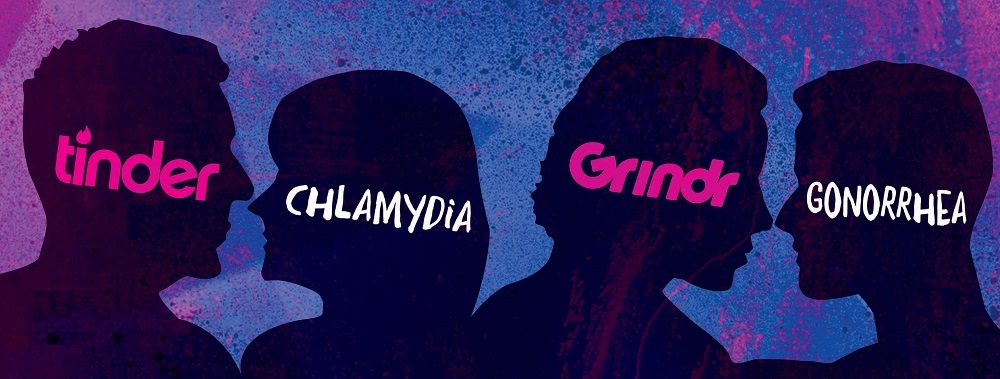
The CBC ran on article by Mark Gollum on Friday about Tinder and Grindr and their perceived roles in the spike of STDs in some regions. With the headline “Blame Tinder, Grindr for the rise in sexually transmitted diseases? Not so fast” the article counter-jabs at those that think the apps, which facilitate casual hook-ups, are to be pointed at as reasons why STIs/STDs are on the rise.
From the article: “…despite all the finger-pointing at these social media dating tools, some researchers say there just hasn’t been enough research done to prove a link between these apps and the rise of sexually transmitted infections.” Well “some researchers” need a lesson in common sense because the question isn’t a matter of research proving “a link” but only a matter of reasoning with percentages that you don’t need a PhD to think critically about.
The main cause of sexually transmitted diseases/infections spreading is sexual intercourse between someone who has an infection/disease and someone who does not: no education is required to know that aside from the standardized information in high school health classes. There are other ways for spreading of the diseases, like dirty needles and blood transfusions, but sex is the main culprit. In situations where a person who isn’t infected is having sex with someone who is, the uninfected person will always be at some risk.
That risk can be mitigated with condom usage, but a percentage chance of transmission is always there, right? That risk is especially high if a condom isn’t used for any length of time due to the two people being overly amorous, right?
I’m asking you because if you agree that a certain percentage risk is always there then you have to agree that anything that increases the amount of sex going on in society, especially unprotected sex, on the macro-level is increasing the transmission of STDs/STIs: the sample space size increasing with the same multiplying percentage for a particular possible outcome increases the mathematical product.
You could identify night clubs, the back seat of a car, prostitution, hormones, or anything else that facilitates sexual contact for contributing to the spread of STDs/STIs. However, when it comes to the RISE of sexually transmitted infections (ie. 80% increase in gonorrhea in Alberta between 2014 and 2015, according to CBC article) you have to look at NEW phenomenon.
From this point of view sex apps are a better explanation than most for the rise. I don’t know much about Grindr, but Tinder was initially released in 2012 and popularized shortly thereafter. It works on your cell phone by connecting you with people around you that are supposedly willing to hook-up. I’ve stated before on Movie TV Tech Geeks that it’s not all it’s cracked up to be based on online opinions I’ve researched and a short-term interest in the app, but in some channels, it clearly has effects on helping people looking for quick adventures find them.
Do you think that Tinder, which markets itself as an app that makes it easier to hook-up, is increasing sexual activity on the whole? Do you agree that some of these hook-ups are going to be high-risk (ie. unprotected)? If you do then it follows that the increased popularity of hookup apps is a factor in increased STI/STD transmission because increased sexual activity increases sexual transmission rates of diseases/infections.
Bang. We’re done.
So why is Gollum quoting Ian Holloway who, according to the CBC article is an “assistant professor of social welfare at UCLA,” when he says “…there’s a big question in my mind about whether these [app] contexts are any more or less risky than those in-person venues,” such as bars.
That “big question” is totally irrelevant to the matter at hand. Apps don’t have to increase the risk on an individual basis, they just need to increase the amount of sex that’s going on. It doesn’t actually matter at all if people having sex out of the bar are more or less likely to increase the spread of STIs or STDs compared to people hooking up off of apps (but why would they be?). In suggesting that “in-person venues” need to be looked at Holloway invokes the old red herring: “in-person venues” have been around forever and therefore don’t explain an alarming INCREASE in STI/STD transmission RECENTLY.
To prove that Tinder/Grindr have helped increase the spread of STDs/STIs all you need to prove is that they increase the amount of sex that goes on, and we don’t need Joe Professor to tell us that it does. Technology makes things easier, so hook-up apps make it easier for some people to find sex.
On that note, sole responsibility for the increase is certainly a different matter. But if we’re going to look at other reasons for the very modern increase in STIs/STDs then we shouldn’t look at “in-person venues” that have been around since time immemorial. Instead, let’s speculate on other things that are new like the current generation of young adults.
The thing about them is that the Internet went mainstream in 1996 and with it came unadulterated access to free pornography that has even shut down Playboy magazine’s offering of nude pictorials. Young adults in their late teens or early 20s nowadays don’t know a time in their life without the Internet and that’s different than people 10 years older or more. I got a bad feeling that people aged 18 to 25 right now have been seeing porn for a lot longer than they should have been.
If that’s having a “monkey-see-monkey-do” effect to any significant extent then it could be leading to a generation, both here-and-now and still coming up, that are more promiscuous than past ones. Looking at that would be an interesting study, especially since porn often depicts unprotected sex.
At bottom the spread of STDs affects individuals and it doesn’t come down to Tinder, Grindr, or online porn but individual decisions. There may be things affecting those individual decisions, and perhaps Tinder, Grindr, and online porn sites might be variables in the chain of events, but that doesn’t mean they are to blame.
Still, maybe these apps/sites could do more to promote safe sex. As a comparison, when you buy a pack of cigarettes you get a pretty stark reminder that they can cause cancer (in Canada, it often says it right on the package). It wasn’t all that long ago that people were saying that a correlation between smoking and dying from cause doesn’t mean causation but we got passed those obtuse individuals and their efforts to obfuscate.
How about instead of getting bogged down by the university guys now, many of which aren’t actually all that bright, and their slow-footed studies that end with the word “inconclusive” all too often we just fast forward. Obviously sex apps are part of the increase of transmission rates of diseases and infections just like it was obvious that smoking caused cancer. In my view, sex apps and sites that depict sex should be required, front and center, to remind about the dangers of sex, especially unprotected, in hopes that it curtails the spread of disease to some extent. The tobacco industry already had to do this in Canada even as the topic of cancer’s causes were debated.


